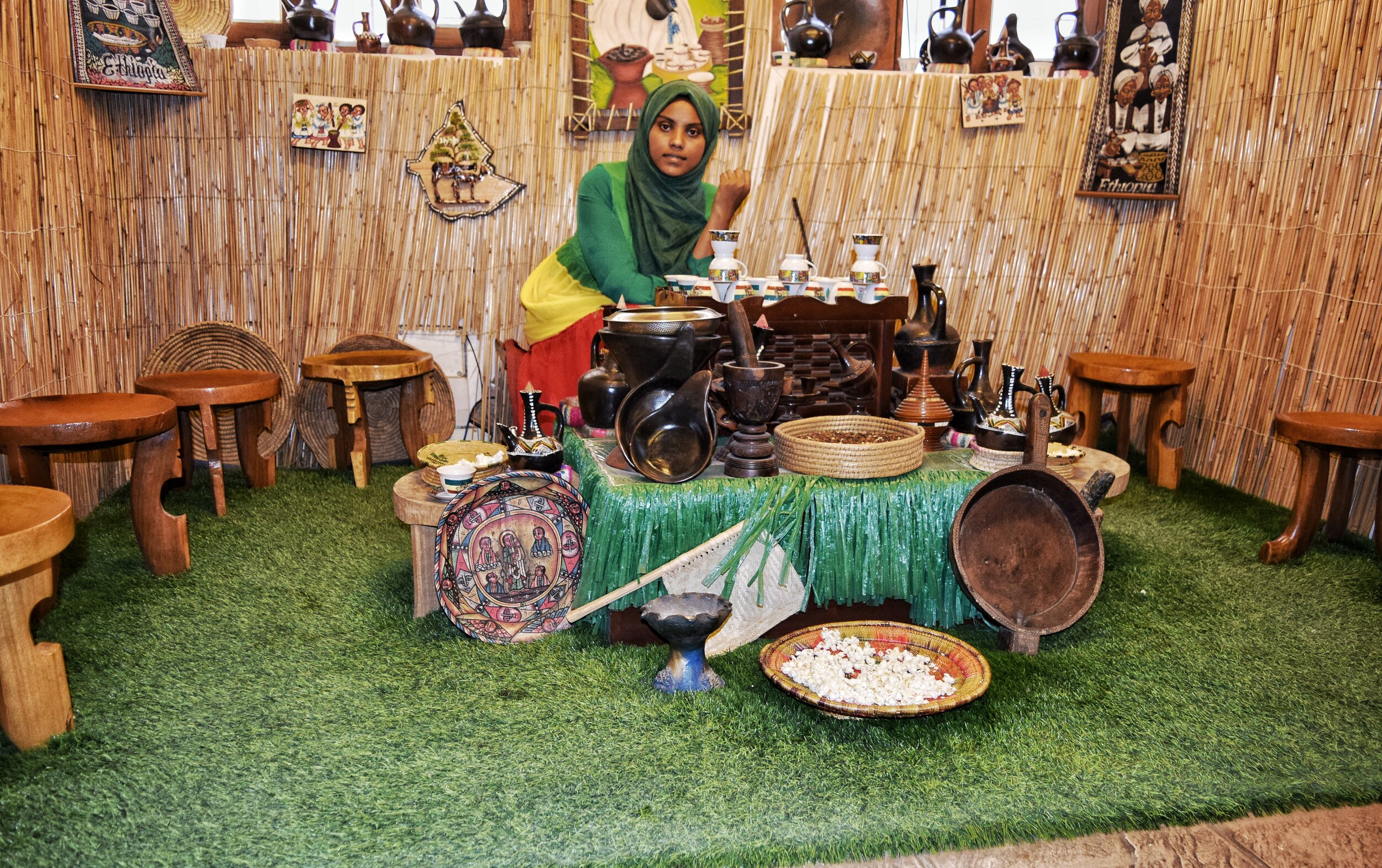The First Cup of Coffee Is the Host’s Gift
Text and Photos by Shoma Abhyankar
Finjan cups with Arabian coffee, or gahwa, served with dates to balance bitterness of coffee.
“We should be leaving now,” Anisa warned me as I finished freshly brewed coffee from finjan,the tiny handle-less cup. My bewilderment prompted her to spill the beans. “When a finjan is served full to the brim, it indicates that the guest may drink and leave.”
This is one of the coffee traditions of Bedouins that continues to be practiced today.
I was visiting the Coffee Museum of Dubai, which in the narrow lanes of old district at Al Fahidi historical neighborhood i, with Anisa, a local who was volunteering as cultural ambassador with Emirati Kashta tours. The museum of coffee, largest in Middle East, is housed in a quaint two-storied traditional Arab house of Khalid Al Mulla. It has an impressive collection of antique vessels like 300-year-old jebena, an Ethiopian clay pot for coffee, vintage implements used for roasting and grinding coffee, maps and literature on coffee history and a majlis area for authentic coffee tasting. A small cafe serves other versions of coffee as well. But it was almost closing time and Khalid Al Mulla, the owner was looking forward to a quiet evening.
As we prepared to leave the museum after a short tour, Anisa told me about the legend of coffee’s origins: Early in fifth century, a goat herder in Ethiopia noticed his goats to be perkier and energetic after eating berries of a shrub. Soon after the discovery of the energzsing red berries, the monks began consuming beans to stay awake for nightly prayers.
It was around seventh century that the Muslim pilgrims took coffee across the Red Sea to cultivate on the fertile land where the roasting and brewing of the bean also evolved and became firmly entrenched in Arab culture. And gradually, by the 16th century, coffee came to be exported to world over from the Mocha port of Yemen.
Better known as gahwa among Emiratis, coffee is a ceremonial affair with distinct hosting etiquettes.
“The coffee became intrinsic to Arab culture,” says Ruqaya Ahmad, a cultural presenter at Sheikh Mohammed bin Rashid Al Maktoum Centre for Cultural Understanding(SMCCU) at Dubai.“The first thing to be offered to a guest at any time of the day, gahwa symbolizes Arab hospitality.”
The cultural importance of gahwa and rituals for Arabs is evident in its inclusion in UNESCO’s list of Intangible Cultural Heritage of Humanity. Abu Dhabi’s Department of Culture and Tourism even sponsors initiatives like Gahwa Championship and Bait Al Gahwa to preserve the cultural heritage by encouraging younger generation to train as heritage experts for tourism projects.
A majlis for women and their female guests. Men and women sit separately.
Accompanied with dates, gahwa is usually served as a welcome gesture to the guests at the majlis, a formal low seating area.
“It is at majlis where important matters like politics, finance, social rituals are discussed over a cup of gahwa,” says Ruqaya.“The young ones of the family are introduced to family traditions here.”
The coffee ceremony involves several specific gestures that communicate intent and messages to the guests without the need to use words. When Bedouins roamed the desert, the act of coffee preparation itself, right from roasting Arabica coffee beans on an open fire to grinding with mortar and pestle and brewing to extract fresh decoction, represented an invitation for anyone to join in.
Dalah a typical long necked ornate vessel with a spout, a lid with finial and thin, curved handle holds the freshly brewed liquid infused with saffron, cardamom and cloves. The server, or gahwaji, the youngest of the family, holds dalah in left hand and serves gahwa from the right hand.
Coffee museum displays vintage coffee grinders and brewing pots.
When the coffee is ready to be served, the gahwaji clinks together the stack of finjan in his right hand and offers al-dhaif, the first of the three rounds of coffee, to the eldest or most important guest seated in the majlis. A tradition carried forward from the harsh nomadic days of Bedouin tribes when each tribe made full use of available resources, the first cup is the host’s gift. Refusal to accept the first cup is considered an insult to the generosity of the host. The second cup, al-kaif, is for pleasure of the brew. Since the nomadic tribes of Bedouins depended on the reciprocation of each other’s generosity and promises to help in time of need, the third cup, al-saif, is served once trust is established between the guest and host.
The quantity of gahwa served also determines if the host is willing to engage. So, while a serving of two-third cup full sends out the message that the guest may continue to enjoy the hospitality, a full cup does not. The guest may shake the finjan to signal that he is done. Placing a finjan on the floor signals the guest’s desire to seek a private audience with the host. Such subtle gestures helped in avoiding embarrassing moments if any.
In fact, heritage expert Abdullah Khalfan al-Yammahi mentions about 44 adab, or etiquettes, of serving and some twenty-two such rules of accepting the gahwa in his book Etiquettes of Gahwa Serving In UAE.
Even with modern glamor and glitz, the younger generation continues to uphold these traditions of famed Arab hospitality. As Ruqaya, in her parting comment, emphasizes “elgehwa lena he akhter min mashroob taqa, elgehwa shaoor kank fe baitek wain ma took.”
Gahwa is more than a drink for us; it is the feeling of home.



